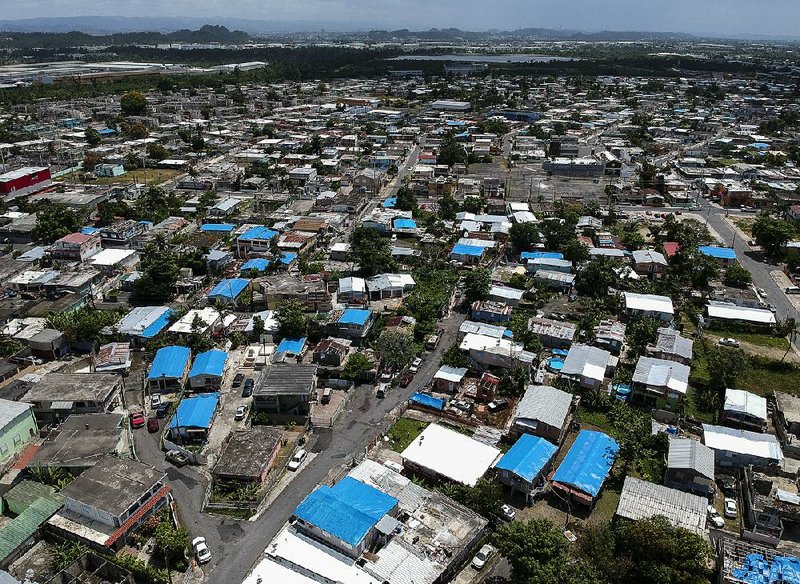SAN JUAN, Puerto Rico -- Thousands of people across Puerto Rico are still living in damaged homes nine months after Hurricane Maria devastated the island.
Blue tarps or sturdier plastic sheets installed by the U.S. Army Corps of Engineers are still widely visible around the island, though the Federal Emergency Management Agency and local government agencies say they can't say for certain how many roofs still need to be replaced.
Many people lack insurance or other resources to rebuild on their own. While the U.S. and Puerto Rican government have helped with grants and loans, they haven't been enough on an island where nearly half of the people live in poverty.
Some are renters like Gabriel Figueroa, a self-employed handyman in San Juan, who said the owner of the house moved to the U.S. and hasn't bothered to replace the roof panels that were blown away in the storm. He's saving up the $2,000 he needs to do it himself, but isn't there yet.
"I don't want to wait much longer," he said. "I have kids, and I have to protect them."
On Wednesday, Puerto Rico's governor signed a bill to privatize the U.S. territory's troubled power company in a move many hope will help minimize power failures that have followed Hurricane Maria.
The Puerto Rico Electric Power Authority is one of the largest U.S. public utilities, and the bill allows for the sale of its power generation plants as the company faces more than $9 billion in public debt and relies on infrastructure nearly three times older than the industry average. It also allows the government to create public-private partnerships for the transmission and distribution of power as well as for services including billing and meter-reading.
"We're here to make transformational changes for Puerto Rico," Gov. Ricardo Rossello said, adding that he believes the law will help attract more investment. "It's no secret that Puerto Rico's economic development has remained stagnant in recent decades."
Rossello said initial market studies have revealed "a lot" of interest in taking over the generation and distribution of power in Puerto Rico.
Rep. Denis Marquez, a member of Puerto Rico's Independence Party, voted against the measure and said the company should be overhauled but remain in government hands.
"Energy is a human right," he said, adding that he believes Puerto Ricans will be hit with higher power bills.
In general, there has been significant progress in recovery. Power, water and cellphone service have been restored to more than 95 percent of Puerto Ricans. Businesses are operating, and the roads are no longer free-for-alls now that many traffic lights are working again. There are signs of economic recovery, with the government reporting last week that unemployment for May was 9.6 percent, the lowest level in almost 30 years.
But housing remains a challenge. Mayor Rafael Surillo of Yabucoa, the small southeastern town near where Maria made landfall, said at least 800 homes there still have temporary roofs in need of replacement. The San Juan mayor's office said there are at least 2,000 such homes in the capital, several thousand more in the metropolitan area.
So many temporary roofs remain, Surillo said, because people either can't qualify for loans or grants -- often because they don't have the titles to their property or are missing documents -- or the amount of assistance they can get isn't enough to cover the cost of repairs. Local officials have been working with people to secure new property title documents, but it has been difficult.
"The reconstruction has been extremely slow, dangerously slow," Surillo said.
FEMA, which was accepting initial applications for assistance through Monday, has had a visible presence on the island, distributing 126,000 blue tarps and coordinating the installation of sturdier, but still temporary, blue plastic sheets by the Corps of Engineers on nearly 60,000 homes. The agency said it has approved 457,000 applications for individual assistance, totaling $1.3 billion.
The federal agency, however, is not set up as a replacement for homeowner's insurance, which a significant portion of Puerto Rico lacks. Spokesman Jo Ann Diaz said FEMA can't make people whole despite expectations to the contrary. "We help you until you are on the road to recovery," she said.
That reality has slowly sunk in across Puerto Rico. Doris Colon and Felix Marquez, an elderly retired couple in Catano, west of San Juan, said they received $500 from FEMA but needed much more after Maria tore off part of their roof, leaving the house exposed to days of punishing rain that damaged appliances, furniture and the floors of their small home.
"If only FEMA would have given something more, I could have called somebody to help me," the 75-year-old Colon said, noting that the family got additional help from the Puerto Rican government and a nongovernmental organization that normally works in Africa.
Others in their neighborhood had similar experiences. Dilma Gonzalez, 47, said she received $132 from FEMA, for damage to her roof and kitchen that a contractor said would cost at least $6,000 to repair. She had no insurance and hasn't worked since the storm.
"I'm worried because it's already storm season, and one little wind will take it all away," she said, gesturing at her house as she chatted with neighbors on the street.
Information for this article was contributed by Danica Coto of The Associated Press.
A Section on 06/21/2018

